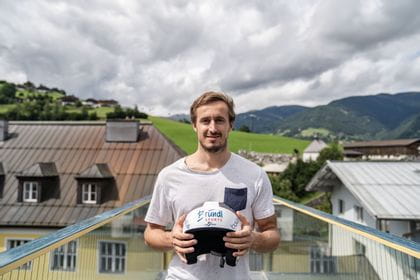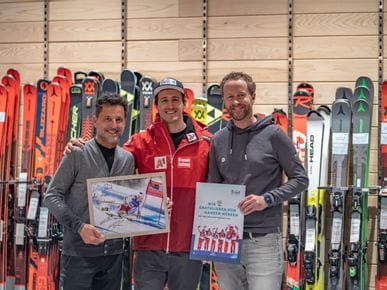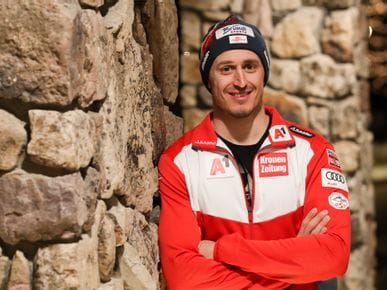Interview with Stefan Brennsteiner - Season recap 2021
After an eventful season, one that began as a “mixed bag” and ended with the best results and first podium finish of his career, Stefan speaks with us about how he views the season and what made this winter so special for him.
“Catch your breath and release the tension of this turbulent season completely.” Advice that World Cup skier Stefan Brennsteiner is also following now the winter is over. With a happy smile and a sense of calmness, the athlete now sits here with us at Bründl Sports in Kaprun, chatting about the past racing season. Aside from his sporting high- and lowlights, he also grants us insights into his inner thoughts, emotions and feelings. What was the secret behind his breakthrough? Together, we look back at Stefan’s season.
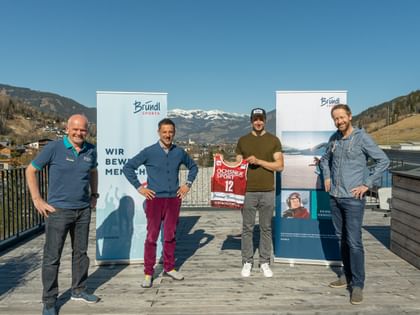
Stefan, you just completed a very successful season. How do you feel?
“Free” – After all those positive events, that’s the best word to describe my current feelings. The tension is subsiding, but at the same time I can feel the tiredness even more. But I need to hang in there just a little bit longer, until it’s finally spring and I can really enjoy the quiet time.
What were your feelings and goals when you began your season in Sölden?
Consistent performances without extremes, that was the plan for the first races to ensure top-30 finishes. That strategy panned out nicely in Sölden where I finished 17th and, for the most part, I was very happy – once again, it was a comeback race after cartilage injury. However, the strategy of achieving consistency didn’t pan out at all in the next race. The strength I used to have, being fast in the flatter segments, just wasn’t there for me either in Sölden or in Santa Caterina. “Hopping mad” is the best way to describe my feelings after the first three races. Skiing consistent runs against this kind of competition simply doesn’t cut it – you have to race.
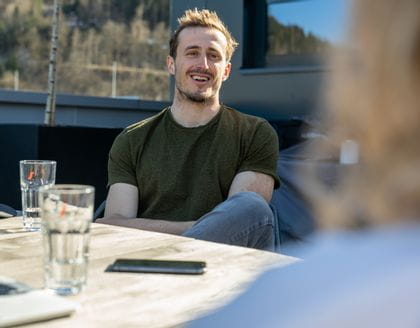
That said, it was a real rollercoaster ride until Bansko – Twice failing to quality for the second run in Sant Caterina, then eighth place in Alta Badia, followed by two blown races in Adelboden. How were those months for you?
After crossing the finish line in Santa Caterina, my first thought was, “I don’t ever want to ski like that again!”. I wasn’t performing at 100% and pure mental strength isn’t enough when it comes to competitive skiing. Instead of skiing with the handbrake pulled tight, I want to bring a positive attitude, have fun, and show what I have in me. Until Alta Badia, our team worked a lot on the equipment to ensure it functioned like it should on the steeper as well as the flatter sections. The plan to remain consistent, but at the same produce the right racing performance, was a persistent theme. The first big success then came with an 8th -place finish in Alta Badia. The whole team celebrated with me. I was finally able to show my potential and gain more confidence. “We’re on the right path and the right course again”, those were my final words in Alta Badia. But unfortunately, in Adelboden, things took a turn for the worse once more. “No… No… No… Already after the first two swings, I realized that something wasn’t right and things weren’t working like I wanted.” The equipment and I simply weren’t in tune, and the mistakes I made because of that were my undoing. In retrospect, definitely a time with lots of highs and lows!

Then came Cortina – you got off to a super start in the first run, seventh place, which put you in a great position – but then you were eliminated in the second run. What did you change after this race? Or rather, to what extent did this race impact you in making your big breakthrough in Bansko?
I can’t give you a clear connection. Looking back, I would say it was probably a big mistake to change equipment between the first and second runs. I was simply trying to make too many adaptations. That said, I didn’t want to waste time dwelling on the World Championships. Instead, I looked forward with confidence and fresh energy to the next race in Bansko. Once again, my ability to live in the present and not get bogged down in the past served me well. Every race is a fresh new start!
Now let’s get to Bansko – would you please describe this first race to us? Why do you think that everything suddenly fell into place? What was different?
Coming out of the first turn, I immediately thought: “Things are clicking today!” “Breakthrough” is definitely the right word for this particular day and race! In both of the previous races, I wasn’t 100% confident and the tension was greater than my enjoyment and abilities, which changed dramatically in Bansko. I am a realist (and also an optimist, of course)! Pure belief in my ability to come out on top isn’t enough for me. I need it black on white, and happily I got the confirmation I needed in Bansko. You have to work hard for a triumph like that, nothing comes from nothing, and that often stretches my patience. But as you can see, sometimes it does pay off to remain patient, get back up again, and keep fighting.

What feelings and thoughts did you have the first time you stood on the podium?
“It was surreal, but incredibly amazing!” The trainers, athletes, and seemingly everyone on the ski circuit celebrated with me. All kinds of wonderful emotions and happy feelings flooded my whole body! At first, I didn’t really know where I should go for the presentation ceremony and what would happen next, but then things went faster than I realized and, before I knew it, I was standing there on the podium. I really appreciated how much positive feedback I got and how much my fans, trainers and support team shared my joy with me. I was happy to finally be able to repay all those people who had pulled for me and supported me over the years. Of course, I missed having the spectators and fans there, but that was also part of the experience!
I assume you received lots of congratulations after that third-place finish – were there any you were especially pleased to receive, or perhaps even surprised you?
“At last, you did it, finally…!” That kind of tribute from so many former and current athletes from different countries touched me a lot personally. The immense joy we get from sport and the solidarity within the community never fail to impress me. In that moment, any hint of competitiveness definitely took a backseat.
My third place was not, thank heavens, a one-day wonder, and I was able to confirm my performance in the following races. Fifth place in the second race in Bansko, another third place in Kranjska Gora, and a fourth place at the World Cup finals in Lenzerheide. I was able to experience that great feeling several times this year and I am proud of myself, and my team, which stood by me in good times and difficult times.
What was, for you, the most challenging race of this season and how did it challenge you?
Because of the changing piste conditions and difficult hill, the most challenging course for me was definitely at the World Championships in Cortina. Alta Badia and Bansko demanded a lot of mental strength since the tension after several defeats in the races before was significant. But as we know, without challenges, you don’t grow.
Have you had time to celebrate your great season and your podium finishes, and if so, how?
Naturally, the current situation doesn’t really allow for big celebrations, but whenever the occasion arose spontaneously, we were happy to chink glasses from time to time. But I am not big into planning – spontaneity is much more my thing – also when it comes to partying. Between races, there is never much time for that kind of stuff because, at the end of the day, it all comes down to how you perform. That said, I really enjoyed the days following the last race, spending time with my family and my girlfriend, having time for myself, time to go ski touring.
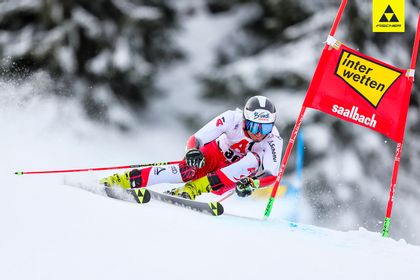
Let’s take a look at the life of an athlete in general. You are the perfect example of someone who has bounced back. After numerous injuries and setbacks, you have always managed to fight back. You were on course for a bronze in the Olympics – then came a torn cruciate ligament again. What kept you going? Do you have a personal tactic, did you change physical or mental aspects of your training?
My passion for the sport of skiing is a major driving force for me personally. And the feeling that I hadn’t yet shown my full potential gave me the extra edge I needed to keep fighting. For me, an injury is nothing more than a set-back. That’s when my mental strength is a real benefit to me since I try to live in the moment and not fret about missed opportunities or make comparisons with situations in the past. You have to accept the current circumstances as they are, try to look forward and make the best of it. Learn to value small successes and stay on course! I also had to constantly remind myself that every injury is different and the healing process will never be the same as for previous or other injuries. When it comes down to it, I am not the most patient of people.
What are your biggest strengths that brought you to where you are now and what are you especially thankful for?
The first big strength is understanding that things never stay the same for long. As I said before, simply live in the here and now, don’t let yourself be influenced too much by things that happened in the past, either positive or negative. A jubilant high one moment, then horribly depressed the next, that’s not me. I’m all about keeping things on an even keel. Secondly, problems can crop up anywhere, anytime, but I don’t let that fact influence or lead me too much. “Life is what you make of it”, as the saying goes. Thirdly, and probably my greatest strength, is understanding my body. In that regard, my injuries weren’t completely negative. Having to focus intensively on areas where you need to improve mentally and physically lets you develop a good sense of where you stand.
For the past five years, Bründl Sports has been at your side as your helmet sponsor. How do you feel about Bründl Sports and what significance does this cooperation have for you?
Bründl Sports is very important for me and is definitely more than just a form of financial support. Quite simply, the package as a whole is perfect! The family atmosphere and the passion for sport which we share can be clearly felt. The personal touch, be that from Christoph Bründl when he sends me a motivating message after every race, or from the rest of the team, is immensely valuable. They are all people with whom you can get along well and who are fun to work with. “Create Emotions” is the motto at Bründl Sports, and that also describes my own career precisely. Five years filled with emotions, highs and lows, victories and defeats! That said, we have so many things in common.
After the season is only a few months before the start of the next season. How are things continuing? What’s on your program? How do you go about training between seasons?
My training is very similar to previous years. Aside from a few little aches and pains, luckily I am not dealing with any more serious injuries that I have to compensate for or rehab. In other words, there’s not something major I have to focus on other than staying physically fit and training well. Now my schedule includes one to two weeks of intensive skiing, before I begin a conditioning program at the end of April. My goal is to improve my endurance at the beginning of summer season, then transition to strength training. In order to stay in good physical condition for sports, I have a training schedule that I adapt weekly together with my trainer. Ski training begins again in August, along with preparations for the season ahead. There’s also a very important training block between Sölden and the races that follow. “But for now, it’s time to ease off a bit and catch my breath!”
